英语六年级上册456单元复习资料
PEP人教版六年级英语上册各单元复习要点
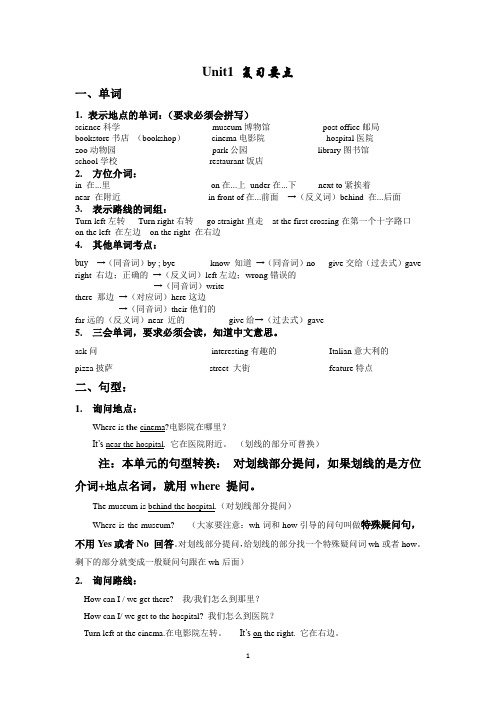
Unit1 复习要点一、单词1.表示地点的单词:(要求必须会拼写)science科学museum博物馆post office邮局bookstore书店(bookshop)cinema电影院hospital医院zoo动物园park公园library图书馆school学校restaurant饭店2.方位介词:in 在...里on在...上under在...下next to紧挨着near 在附近in front of在...前面→(反义词)behind 在...后面3.表示路线的词组:Turn left左转Turn right右转go straight直走at the first crossing在第一个十字路口on the left 在左边on the right 在右边4.其他单词考点:buy →(同音词)by ; bye know 知道→(同音词)no give交给(过去式)gave right 右边;正确的→(反义词)left左边;wrong错误的→(同音词)writethere 那边→(对应词)here这边→(同音词)their他们的far远的(反义词)near 近的give给→(过去式)gave5.三会单词,要求必须会读,知道中文意思。
ask问interesting有趣的Italian意大利的pizza披萨street 大街feature特点二、句型:1.询问地点:Where is the cinema?电影院在哪里?It’s near the hospital. 它在医院附近。
(划线的部分可替换)注:本单元的句型转换:对划线部分提问,如果划线的是方位介词+地点名词,就用where 提问。
The museum is behind the hospital.(对划线部分提问)Where is the museum? (大家要注意:wh-词和how引导的问句叫做特殊疑问句,不用Yes或者No 回答。
PEP英语六年级上册各单元知识点归纳及练习+总复习单词归类
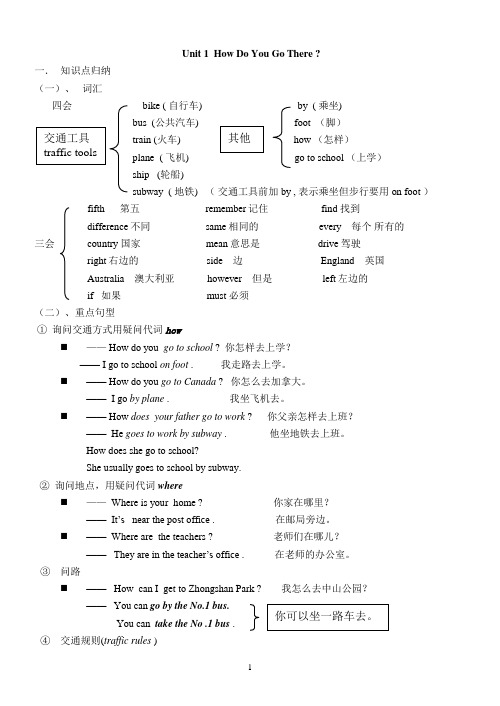
Unit 1 How Do You Go There ?一. 知识点归纳(一)、 词汇四会 bike ( 自行车) by ( 乘坐)bus (公共汽车) foot (脚)train (火车) how (怎样)plane ( 飞机) go to school (上学)ship (轮船)subway ( 地铁) ( 交通工具前加by , 表示乘坐但步行要用on foot ) fifth 第五 remember 记住 find 找到 difference 不同 same 相同的 every 每个 所有的三会 country 国家 mean 意思是 drive 驾驶right 右边的 side 边 England 英国Australia 澳大利亚 however 但是 left 左边的if 如果 must 必须 (二)、重点句型① 询问交通方式用疑问代词how⏹—— How do you go to school ? 你怎样去上学? —— I go to school on foot . 我走路去上学。
⏹—— How do you go to Canada ? 你怎么去加拿大。
—— I go by plane . 我坐飞机去。
⏹ —— How does your father go to work ? 你父亲怎样去上班?—— He goes to work by subway . 他坐地铁去上班。
How does she go to school?She usually goes to school by subway.② 询问地点,用疑问代词where⏹—— Where is your home ? 你家在哪里? —— It’s near the post office . 在邮局旁边。
⏹—— Where are the teachers ? 老师们在哪儿? —— They are in the teacher’s office . 在老师的办公室。
新版pep六年级上册英语各单元知识点总结
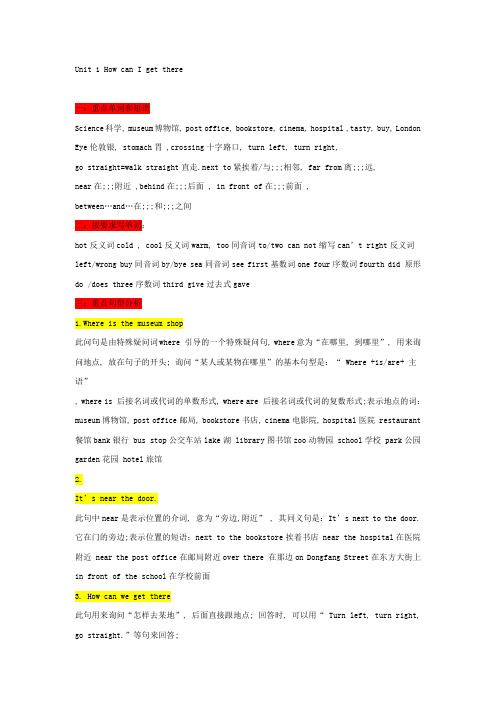
Unit 1 How can I get there一:重点单词和短语Science科学, museum博物馆, post office, bookstore, cinema, hospital ,tasty, buy, London Eye伦敦银, stomach胃 ,crossing十字路口, turn left, turn right,go straight=walk straight直走.next to紧挨着/与;;;相邻, far from离;;;远,near在;;;附近 ,behind在;;;后面 , in front of在;;;前面 ,between…and…在;;;和;;;之间二:按要求写单词:hot反义词cold , cool反义词warm, too同音词to/two can not缩写can’t right反义词left/wrong buy同音词by/bye sea同音词see first基数词one four序数词fourth did 原形do /does three序数词third give过去式gave三:重点句型分析1.Where is the museum shop此问句是由特殊疑问词where 引导的一个特殊疑问句, where意为“在哪里, 到哪里”, 用来询问地点, 放在句子的开头; 询问“某人或某物在哪里”的基本句型是:“ Where +is/are+ 主语”, where is 后接名词或代词的单数形式, where are 后接名词或代词的复数形式;表示地点的词:museum博物馆, post office邮局, bookstore书店, cinema电影院, hospital医院 restaurant 餐馆bank银行 bus stop公交车站lake湖 library图书馆zoo动物园 school学校 park公园garden花园 hotel旅馆2.It’s near the door.此句中near是表示位置的介词, 意为“旁边,附近” , 其同义句是:It’s next to the door.它在门的旁边;表示位置的短语:next to the bookstore挨着书店 near the hospital在医院附近 near the post office在邮局附近over there 在那边on Dongfang Street在东方大街上in front of the school在学校前面3. How can we get there此句用来询问“怎样去某地”, 后面直接跟地点; 回答时, 可以用“ Turn left, turn right, go straight.”等句来回答;同义句:1.Can you tell me the way to+地点2.Where is the +地点3.Which is the way to +地点4.Turn left at the bookstore. Then turn right at the hospital.此句是指路的句型; 常用到的句型有:turn left, 向左转turn right, 向右转go straight直着走;同时表示在某处的介词用at.5.Is the Thames far from hereNo, it isn’t.此句是个be动词开头的一般疑问句, 其回答要用Yes或No. 句中的far from意为“离……远”;反义词组为next to.Unit 2 Ways to go to school一:重点单词和短语on foot步行, by bus =take a bus 乘公交车 by plane,乘飞机 by taxi 乘出租车by ship乘船 by subway 乘地铁by train乘火车 by bike骑自行车by ferry 乘轮渡Hooray好极了slow down 慢下来, stop 停 wait等 pay attention to注意 cross the road 横穿马路 traffic light通信号灯at home在家 missedmiss的过去式想念different,不同chopsticks,筷子复数cross穿过look right向右看 same 相同的door门look at朝;;;看play with和;;;一起玩二:按要求写单词:go 反义词come foot复数feet child复数childrenearly反义词late good反义词bad坏 take带走反义词bring拿来slow反义词quick/fast go 过去式went do过去式 diddo第三人称单数 doesgo第三人称单数 goessame 相同的反义词different不同的miss过去式 missedwrong 错误反义词right正确 can否定形式can’t三:重点句型分析1.How do you come to school你们怎么来学校的此问句是由特殊疑问词how引导的特殊疑问句, 用于询问对方的出行方式; 回答时要根据具体情况作答;表示地点的词:Germany德国 Munich慕尼黑 England英国 Australia澳大利亚school学校 the park 公园the cinema电影院 the hospital医院 the post office邮局the bus stop公共汽车站 home家2.Usually, I come on foot.=Usually, I walk.通常情况下,我步行来;此句是对出行方式的回答句; 其中usually意为“通常”, 表示频率很大, on foot意为“步行”; 一般用by表示出行方式; By后面一定要直接加交通工具的单数形式, 只有“小脚丫”foot与on 搭配, “步行”用on foot表示;3.I must pay attention to the traffic lights.我必须注意交通信号灯; Must是情态动词,意为“必须”后面跟动词原形;动作词组:wear a helmet戴头盔 pay attention to the traffic lights注意交通信号灯look right向右看4.Don’t go at the red light别闯红灯此句是Don’t开头的否定祈使句, don’t后面跟动词原形;意为“不要做某事”;动作词组:run跑 go at the red light闯红灯 touch the door触摸门Eg. Don’t smoke.不要吸烟;/禁止吸烟;Don’t take photos.禁止拍照;5We must look right before crossing the road.我们在横穿马路前必须看看右边;此句中must是情态动词, 意为“必须”后面跟动词原形, 在此句中before是一个介词, 而介词后面跟动词-ing形式;6. There is no door on the bus.公共汽车上没有门;此句是there be句型的单数句, be动词要根据后面名词的单复数形式来决定, 名词为单数或不可数名词就用there is, 名词为复数就用there are. 此句中no door意为“没有门”, 表示单数含义,因此要用there is开头;Unit 3 My weekend plan一:知识点小结重点单词和短语visit拜访film电影 see a film看电影 trip旅游take a trip去旅游supermarket, 超市evening晚上,傍晚 tonight在今晚tomorrow明天next week下周dictionary 字典comic 滑稽的comic book连环画册word book单词本postcard明信片learn 学习teach教disturb打扰 without没有pool池子 jump in跳进 remember记住 lesson 课space太空 travel尤指长途旅游 half一半 price 价格moon月亮make a snowman 堆雪人share sth事 with sb人和某人分享某物lots of= a lot of 许多二:按要求写单词look for 同义词 find leaf 复数 leaves picture 复数 picturessee 同义词 watch/look film 同义词 movie buy 反义词 sellam /is /are 原形 be is /am 复数are this 反义词 thatgoing 原形 go swim 现在进行时swimming can否定形式can’ttoo同音词 two /to clothe复数clothes ice-skate现在进行时ice-skating autumn同义词 fall autumn反义词spring teach 反义词 learn三:重点句型分析1.---What are you going to do tomorrow---I’m going to have an art lesson.此句是个一般将来时态的特殊疑问句; 用了be going to 结构; “be going to +动词原形”构成一般将来时态, 表示计划、安排将要做的事或根据目前推测将要发生的动作, 意为“打算, 将要”;表示时间的单词:evening晚上,傍晚 tonight在今晚tomorrow明天next week 下周this morning今天早晨 this afternoon今天下午 this evening 今天晚上 this weekend 下周末动词短语原形:make a snowman 堆雪人 take a trip去旅游see a film看电影 visit my grandparents 拜访祖父母watch TV看电视learn how to swim学怎样游泳go skating去滑冰row a boat划船go fishing 去钓鱼 go skiing去滑雪 go shopping去购物 make mooncakes做月饼 read a poem读诗eg: I’m going to make a snowman.我打算去堆雪人;We’re going fishing.我们打算去钓鱼;2.We are going to draw some pictures in Renmin Park.此句是be going to 结构的肯定句式; 基本结构为:主语+ be going to +动词原形+表示将来的时间;Some一些,用于肯定句中, 后接可数名词的复数形式或不可数名词, 而在疑问句或否定中表示一些要用any;3---Where are you going---We’re going to the cinema.此句是where 引导的一般将来时态的特殊疑问句, where意为“哪里”, 它是对地点提问的特殊疑问词, 因此回答时要回答一个具体的地点;表示地点的词:school学校 park 公园 cinema电影院 hospital医院 post office邮局 bus stop公共汽车站 home家 supermarket超市museum博物馆, bookstore书店 , restaurant餐馆bank银行lake湖 library图书馆zoo动物园park公园garden花园 hotel旅馆4---When are you going---Next Monday.此句中when意为“什么时候, 何时”, 它引导的疑问句用来对年、月、日等时间进行提问; 如:---When do you go to school in the morning---At 8:00.5---How can you learn to swim without going to a pool此句是由how 引导的特殊疑问句, 询问别人做事的方式、方法; 句中的can 意为“能够”, 是情态动词,后面跟动词原形; “learn to do something,”学习做某件事, 一般表示还没学或还没做的事情,含义将来的意思;第四单元Unit 4 I have a pen pal一、重点单词和短语pen pal笔友hobby爱好 idea主意studies学习第三人称单数 puzzle谜语hiking徒步旅行forest森林 gift礼物 sometimes有时 angry,生气shout大喊 bushy浓密的 have to不得不get … from…,从;;;得到;;;reading books 读书read stories读故事 do kung fu练功夫 play sports 进行体育运动play the pipa 弹琵琶climb mountains爬山 listen to music听音乐 sing English songs 唱英文歌fly kites放风筝 on a farm在一个农场里 write an e mail to 给;;;写封电子邮件 on the playground在运动场上六 live in住在;;;按要求写单词二、按要求写单词have第三人称单数 has do三单形式does do 否定形式don’tdoes 否定形式doesn’t like 三单形式likes he 所有格形式 histalk动词-ing形式 talking hobby三单形式hobbies story三单形式 stories read三单形式 reads live三单形式 lives swim动词-ing形式 swimmingdo动词-ing形式 doing sing动词-ing形式 singing go动词-ing形式 going teach动词-ing形式 teaching also同义词 too play动词-ing形式 playing student复数students dance动词-ing形式dancing write动词-ing形式writing puzzle复数puzzles hike动词-ing形式 hiking learn动词-ing形式learningfriend复数 friends cook三单形式cooks study三单形式 studiesgo 三单形式goes teach三单形式teaches different反义词 samemake三单形式makes talk 三单形式talks love 三单形式lovessleep三单形式 sleeps let三单形式lets sing三单形式 singsdance 三单形式dances sang 原形sing was原形 is/amthrew原形throw looked原形 look did原形do/does true反义词false三、重点句型分析1.问:What are sb’s hobbies 某人的爱好是什么询问某人的爱好答:主语 +like/likes +动词-ing形式+其他; ;;;喜欢;;;此处是对别人的爱好提问及回答的句型,问句中一般hobby要用复数形式, 因为别人的爱好不只一个, 特别注意hobby一词的复数形式变化规则, 变y为i再加-es;答句是一般现在时态的三单人称的句型; 当主语是第三人称单数时, 后面的动词要用它的第三人称单数形式, 同时like意为“喜欢”, 而喜欢做某事2.结构:like + v-ing 即like 后面跟动词的-ing形式Eg: What are Peter’s hobbies He likes reading stories.动词-ing形式:singing唱歌 dancing跳舞 reading stories 读故事playing football踢足球 doing kung fu 练功夫doing word puzzle猜字谜 go hiking 远足 watching TV看电视 drawing pictures 画画listening to music听音乐going fishing 钓鱼3、Does he live in SydneyNo, he doesn’t.此句是助动词does开头的一般疑问句; 其回答要根据助动词和主语来决定;结构为“Does+ 三单人称+ 动词原形”, 肯定回答结构: Yes, 主语+ does, 否定回答结构: No, 主语+ doesn’t. 4、So he doe sn’t like Zac’s music.此句是含有实意动词的否定句, 其结构为:主语+ don’t/ doesn’t+ 动词原形+其他; 当主语是第三人称单数时, 后面的否定助动词要用doesn’t而不是don’t;Unit 5 What does he do 知识点总结一:重点单词和短语factory工厂 worker,工人postman,邮递员businessman商人 police officer警察fisherman 渔民 scientist,科学家pilot飞行员 coach教练job工作, tamer驯服手 dangerous危险farmer农民 honey蜂蜜 stung叮 assistant助手接待员cracker骇客解密高手 nuts果仁think of考虑/有;;;想法go to work去工作 study hard努力学习 stay healthy保持健康 go home 回家 lots of许多 go to the camp去度假营 be good at擅长;;;head teacher校长二:按要求写词语do三单 does work三单 works he主格 his所有格 him宾格she主格 her宾格或所有格 business名词 businessmanfish名词 fisher can 否定形式can’t drive 名词driver teach 名词teacher country复数countries clean名词cleaner write 名词writer sing名词singer dancer 动词dance player 动词 play worker动词 work is否定形式isn’tgo现在分词 going see三单 sees big 反义词smalltall 反义词short thin反义词 fat/strong short 反义词tall/longsea同音词 see lots of =a lot of has 原形havehealthy名词 health life 动词live hard反义词 easy stay三单 stays study 三单studies science名词 scientist university复数 universities those反义词 thesedifferent 反义词same like三单 likes go三单 goes want三单 wants run现在分词 running report 名词reporter use现在分词 using quick 副词quickly they主格 them宾格 their所有格 children 单数child didn’t 否定形式don’t /doesn’t unusal 反义词usual dangerous 反义词safe farm名词 farmer test名词 tester eat 现在分词eating have三单has三:重点句型分析1.What does he doHe’s a businessman.这是一个询问职业的句型, 它的构成是“ What do/ does+某些人+do”, 可以用“某人+ be+a/an+职业名词”来回答; 询问职业还有一个句型是“ What + be+某人”; 如上面的句子还可以说“ What is he ”;表示职业的词:worker工人 postman邮递员businessman商人coach教练police officer警察 fisherman渔民 scientist,科学家pilot飞行员tamer驯服手farmer农民assistant助手接待员teacher老师 cleaner清洁工doctor医生nurse护士 dentist牙医 tailor裁缝 salespersons售货员 pianist钢琴家2 .---Where does he work---He works at sea.当你想询问他人在哪儿工作时, 用“ Where do/ does+ 某些人+ work”这个句型; 我们通常用一个表示地点的介宾短语来回答这个句型; 介宾短语是由介词加上名词或代词构成的;表示地点的介词短语:at a university 在一所大学in a gym在一个体育馆at sea 在海上on a boat在船上 at the zoo在动物园 in a school 在一所学校in a car company在一家汽车公司 in a bank在一家银行3. ---How does he go to work---He goes to work by bike.要询问别人的上班方式, 可以用“ How do/ does+人物+ go to work”句式来询问, 回答时要用到”by+交通工具的单词“或者是on foot;表示交通方式的词: by the No.15 bus乘15路公交车on foot步行,by bus 乘公交车 by plane,乘飞机 by taxi 乘出租车by ship乘船by subway 乘地铁bytrain乘火车 by bike骑自行车by ferry乘轮渡4. What a great job此句是由“what”引导的感叹句:“what”意为“多么”用作定语,修饰名词被强调部分,单数可数名词前要加不定冠词a/an,复数可数名词或不可数名词前不用冠词;这类句子的结构形式是:What+a/an+形容词+名词+主语+谓语+it is. 如:What a clever girl she is多么聪明的姑娘呀Unit6 How do you feel一:重点单词和短语Angry生气afraid害怕 sad伤心worried担心 happy快乐see a doctor看医生wear穿 more,更多deep身 breath呼吸 take a deep breath深呼吸count to ten 数到十popcorn爆米花make,制作wait等check检查planted种植的过去式grow生长或成长a little worried有一点点担心be angry with…与;;;生气be afraid of ;;;害怕;;;domore exercise做更多的运动 wear warm clothes穿暖和的衣服 get some drinks 拿一些饮料 have some popcorn 吃一些爆米花chase the mice追赶老鼠二:按要求写词语First基数词one chase 三单chases mice单数 mouse chase 现在分词chasing these 反义词those these单数 this sad反义词 happy here反义词 there can’t 肯定形式can can’t 完全形式can not don’t完全形式 do not feel 三单feels friends 单数friend suggestions单数 suggestion warm 反义词cool cold 反义词hot clothes单数clothe much 比较级more worry形容词worried sunny名词 sun hears 动词原形hear say 三单says strong反义词thin strong 近义词fat should否定形式shouldn’t picture复数 pictures ant复数 ants tell反义词 retell hungry反义词 full bad 反义词good ill 反义词 healthy making原形 make doing 原形do planted 原形plant plant 动词过去式 planted waiting动词原形 wait三:重点句型分析1.They are afraid of him.此句中be afraid of 意为“ 害怕某人”; 例如: I am afraid of my maths teacher. 我害怕我的数学老师;2.The cat is angry with them.此句中be angry with意为“ 对某人生气”;例如: I broken the cup. My mother is angry with me. 我打碎了杯子; 妈妈对我很生气;3.What’s wrong此句用于询问对方有什么问题或有什么不顺心的事情, 意为:怎么啦出什么事了例如:A: What’s wrong, Jim 吉姆,你怎么啦B: Maybe I am ill. 也许我病了;4.He should see a doctor this morning建议某人应该做某事的句型此句中should 为情态动词,表示“应该,应当”;此句用来给别人提建议;例如:He should work harder. 他应该更加努力;You should help your mother with the housework. 你应该帮你母亲做家务;5. What are you doing此句是现在进行时态的特殊疑问句, 其基本结构为:疑问词+be+主语+其他例如:What is he doing now回答:He is swimming.肯定句结构为:主语+be+动词-ing形式+其他.例如:We are running now。
pep人教版2020小学英语总复习六年级上册5、6单元复习课件PPT文档

She sells things. 她卖东西的。 She is a salesperson. 她是一个销售员。 He helps sick people. 他帮助生病的人。 He is a doctor. 他是一个医生。 She cleans streets.她打扫街道的 She is a cleaner. 她是一个清洁工。 She draws pictures. 她画画的 She is an artist. 她是一个画家。 He drives cars. 他开车的 He is a driver. 他是一个司机。
他的姐姐是做什么的? What does his sister do?
你是做什么的? 他们是做什么的?
What do you do? What do they do?
拓展一
询问职业还有其他方法吗?
她是做什么的?
What is she ?
你的父亲是做什么的? What is your father ?
__Is__ _h_e__ a TV reporter? (否定回答)
_N__o_, _h_e__ __is_n_’_t _.
My uncle is an actor.(对画线部分提问)
_W__h_a_t_ __d_o_e_s_ your uncle _d_o_?
Ann goes to school on foot. (对画线部分提问)
他的姐姐是做什么的? What is his sister?
你是做什么的?
What are you ?
他们是做什么的? What are they ?
(完整word版)pep六年级上册英语-各单元知识点总结
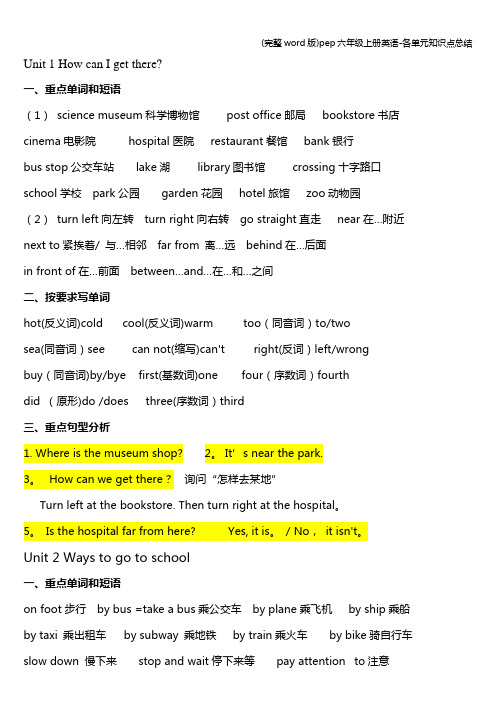
Unit 1 How can I get there?一、重点单词和短语(1)science museum科学博物馆post office邮局bookstore书店cinema电影院hospital医院restaurant餐馆bank银行bus stop公交车站lake湖library图书馆crossing十字路口school学校park公园garden花园hotel旅馆zoo动物园(2)turn left向左转turn right向右转go straight直走near在…附近next to紧挨着/ 与…相邻far from 离…远behind在…后面in front of在…前面between…and…在…和…之间二、按要求写单词hot(反义词)cold cool(反义词)warm too(同音词)to/twosea(同音词)see can not(缩写)can't right(反词)left/wrongbuy(同音词)by/bye first(基数词)one four(序数词)fourthdid (原形)do /does three(序数词)third三、重点句型分析1. Where is the museum shop? 2。
It’s near the park.3。
How can we get there?询问“怎样去某地”Turn left at the bookstore. Then turn right at the hospital。
5。
Is the hospital far from here? Yes, it is。
/ No,it isn't。
Unit 2 Ways to go to school一、重点单词和短语on foot步行by bus =take a bus乘公交车by plane乘飞机by ship乘船by taxi 乘出租车by subway 乘地铁by train乘火车by bike骑自行车slow down 慢下来stop and wait停下来等pay attention to注意cross the road横穿马路traffic light通信号灯at home在家look right向右看look at朝…看play with和…一起玩二、按要求写单词go (反义词)come foot(复数)feet child(复数)childrenearly(反义词)late good(反义词)bad take(反义词)bringslow(反义词)quick/fast go(过去式)went do(过去式)diddo(第三人称单数) does go(第三人称单数)goessame 相同的(反义词)different不同的miss(过去式)missedwrong 错误(反义词)right正确can(否定形式)can’t三、重点句型分析1。
牛津小学英语六年级上册1-4单元总复习知识点和练习

6AUnit 1重点短语long long ago很久以前make sth for sb为某人制作...... show sb. sth.= show sth. to sb把.某物展示给某人看walk through 步行穿过 try on试穿shout at sb.对某人大叫laugh at sb.对某人大笑look at看⋯.point at指向⋯tell sb. sth告.诉某人某事 it is one’ s turn某人的机会in front of在⋯.前面(外部)turn into变成in the front of在⋯ 前面(内部)think hard努力思考be nice to sb.对某人好句型1.Long long ago, there was a king. 很久很久以前,有一位国王。
2.The king was happy. 国王很开心。
3.He liked new clothes. 他喜欢新衣服。
4.Two men visited the king. 两个男人拜访了这位国王。
语法1.掌握动词过去式的变化规则2.there be句型的过去时句型转换语音1.考查字母组合 ar 发音3.考查动词的过去式 ed 的发音Unit 1 错题集精选一、找出与所给单词的划线部分读音相同的选项。
()1. farm A. ear B. quarter C. hard()2. walked A. looked B. played C. shoutedht二、单项选择( ( ( ( ()1. I ________ TV a moment ago.A. watchB. watchedC. looked)2. Tom ________ the farm _______ his family yesterday.A. visit, withB. visited, forC. visited, and)3. It ’s seven o’clock. David has to ________.A. go to schoolB. going to schoolC. went to schoolD. goes to school)4. Each student one picture.A. drawB. drawsC. drawing)5. She usually _______ new clothes his doll.D. lookD. visited, withD. to drawing( ( ( ( (A. makes, withB. make , forC. makes, forD. make, with)6. The lion always walks ______ the forest every day.A. onB. underC. throughD. behind)7. The witch( 女巫 ) the prince a lion.A. turned , onB. talked, with ,C. told , aboutD. turned ,into )8. The clothes are beautiful. Please ______________.A. try it onB. try on themC. try them onD. try on it)9. The shoes are very cool, but they me.A. are fittingB. fitC. don’tfitD. fitted)10. Yesterday Nancy was sick, her mother her carefully.A. looked afterB. looked atC. looked forD. looked out三、句型转换1. The two men showed the king his new clothes.(同义句转换)The two men his new clothes the king.2. There were some apples in the street. (改为否定句)There _________ _________ apples in the street.3. My uncle lives in a big city.(用two years ago改写)My uncle ________ in a big city two years ago.答案:一1.C2.A解析:清辅音 +ed,发 /t/; 浊辅音或元音 +ed,发 /d/; t+ed, 发 /id/二1.B解析:出现 ago,所以用过去时,看电视应该用watch2.D解析:出现 yesterday 用过去时, with 表示“和” ,放在句末3.A解析: have to 中 to 后面用动词原形4.B解析: each 后接单数可数名词,且谓语动词用单数5.C解析: usually 用一般现在时,主语为第三人称单数,所以用三单式;make sth for sb6.C解析:考查方位介词,“穿过森林”应该用through;7.D解析: turn sb into ... 固定短语8.C解析: try on 表示“试穿” ,后接代词用宾格,且放在中间9.C解析:根据 but 这一转折,所以要用否定,fit 的否定要用助动词do10.C 解析: look 的短语, look after 照顾, looked at 看 ......, looked for 寻找, looked out向外看三1.showed to 解析:考查 show 的短语2.weren’t any 解析:考查一般过去时的否定句转化3.lived 解析:考查动词的过去式Unit 2重点短语by bike 骑自行车look sad 看起来伤心hold on抓紧fly away飞走= ride a bike骑自行车on Monday morning在星期一早上难点:表示天气的名词与相应的形容词转化rain( 名词 )rainy(形容词)rain( 动词 )句型1. It was sunny / cloudy/ windy. 天气是晴朗的/ 多云的 / 有风的。
六年级上册1~4单元知识点英语

六年级上册1~4单元知识点英语一、词汇1. 名词复数形式在英语中,名词的复数形式有一定的规则,例如一般在名词末尾加-s或-es,有些名词则需要变换字母形式,如man变为men,child变为children等。
2. 动词的时态英语动词的时态包括一般现在时、一般过去时、一般将来时等。
学生需要掌握动词的不同时态形式及其用法。
3. 形容词和副词形容词用来修饰名词,而副词则用来修饰动词、形容词或者其他副词。
学生需要了解形容词和副词的用法,掌握其比较级和最高级的变化规律。
4. 代词代词用来代替名词,分为人称代词、物主代词、指示代词等。
学生需要熟练掌握不同类型代词的用法和变化。
5. 介词短语介词短语是由介词和宾语组成的词组,用来表示名词或代词与其他部分之间的关系。
学生需要学习介词短语的基本用法及常见搭配。
6. 情态动词情态动词用来表达说话人的态度、能力、意愿等,包括can、could、may、might、should、shall、will、would等。
学生需要掌握情态动词的用法及其不同意义。
7. 数词数词用来表示数量,包括基数词和序数词。
学生需要学会基数词和序数词的用法及其变化规则。
二、语法1. 一般现在时一般现在时表示经常性、习惯性的动作或客观事实。
句子的肯定形式中,主语加动词原形;否定形式中,在动词前加助动词do或does,并在动词后加not;疑问形式中,助动词do或does置于主语之前。
2. 一般过去时一般过去时表示过去某个时间里发生的动作或状态。
句子的肯定形式中,动词变为过去式;否定形式中,在动词前加助动词did,并在动词后加not;疑问形式中,助动词did置于主语之前。
3. 一般将来时一般将来时表示将来某个时间或某个时间的系列动作。
句子的肯定形式中,将来时态由助动词shall或will加动词原形构成;否定形式中,在助动词后加not;疑问形式中,将来时态由助动词shall或will置于主语之前。
4. 句子的基本结构英语句子的基本结构由主语、谓语和宾语构成。
六年级英语上册各单元复习要点全部

六年级英语上册各单元复习要点全部Establish standards and manage them well. January 26, 2023U n i t1复习要点一、单词1.表示地点的单词:要求必须会拼写science科学 museum博物馆 post office 邮局bookstore书店 bookshop cinema电影院 hospital医院zoo动物园 park公园 library图书馆school学校 restaurant饭店2.方位介词:in 在...里 on在...上 under在...下 next to 紧挨着near 在附近 in front of在...前面→反义词behind 在...后面3.表示路线的词组:Turn left左转 Turn right右转 go straight直走 at the first crossing在第一个十字路口on the left 在左边 on the right 在右边4.其他单词考点:buy →同音词by ; bye know 知道→同音词no give交给过去式gaveright 右边;正确的→反义词left左边;wrong错误的→同音词writethere 那边→对应词here这边→同音词their他们的far远的反义词near 近的 give给→过去式gave5.三会单词,要求必须会读,知道中文意思;ask问 interesting有趣的 Italian 意大利的pizza披萨 street 大街 feature 特点二、句型:1.询问地点:Where is the cinema电影院在哪里It’s near the hospital. 它在医院附近; 划线的部分可替换注:本单元的句型转换:对划线部分提问,如果划线的是方位介词+地点名词,就用where 提问;The museum is behind the hospital.对划线部分提问Where is the museum 大家要注意:wh-词和how引导的问句叫做特殊疑问句,不用Yes或者No 回答;对划线部分提问,给划线的部分找一个特殊疑问词wh-或者how;剩下的部分就变成一般疑问句跟在wh-后面2.询问路线:How can I / we get there 我/我们怎么到那里How can I/ we get to the hospital 我们怎么到医院Turn left at the cinema.在电影院左转; It’s on the right. 它在右边;3.重点句型及考点:⑴ want to 想要+ 动词原形“想要做某事”I want to buy a postcard. 我想买一张明信片;I want to send it today. 我想今天邮寄它;I want to be a businessman.我想成为一名商人;⑵ I’ll 完整形式: I willShe’ll 完整形式 She will will 将要+动词原形一般将来时的构成will+动词原形I’ll ask. 我要问一问;She’ll be here today. 她今天会来这里;⑶A talking robot一个会说话的机器人⑷感叹句: What a great museum 多么棒的博物馆啊What an interesting film 多么有趣的电影啊⑸It’s near the museum. 它在博物馆附近;It’s next to the museum. 它紧挨着博物馆;注:在位置上这两个单词区别不大,但是一定要注意 next 必须和to 连用,而 near后面直接+the + 地点名词⑹There is a pet hospital in my city.我的城市有个宠物医院;→一般疑问句Is there a pet hospital in your city.你的城市有宠物医院吗句子当中有be动词,变成一般疑问句就把Be动词提前,如果原句中有I 问句变you, 如果原句有my 问句变your→肯定回答: Yes, there is. 是的,有;→否定回答:No, there isn’t. 不,没有; 这是There be 句型一般疑问句的回答;→否定句:There isn’t is not a pet hospital in my city. 我的城市没有宠物医院;句子中含有be动词,否定句在be动词后+notis not → 缩写isn’t are not →缩写aren’t I am not →缩写I’m not⑺I know a great Italian restaurant. 我知道一家很棒的意大利餐厅;an Italian restaurant一家意大利餐厅⑻It’s next to the park on Dongfang Street. 它在东方街公园旁边;⑼Robin has GPS Robin 有GPS Robin为第三人称单数所以have要用三单形式has⑽My new GPS works. 我的新的全球定位系统起作用过了;My new GPS也是第三人称单数,所以work要用works⑾We’re in front of the cinema. 我们在电影院前面→同义句The cinema is behind us. 电影院在我们后面;⑿Is the Thames far from here 泰晤士河离这里远吗⒀It’s next to the film museum near the Thames. 它紧挨着泰晤士河附近的电影博物馆;Unit2 复习要点一、单词1.出行方式by bus 乘公交车 by plane 坐飞机 by taxi 坐出租车by ship坐船 by subway坐地铁 by train 坐火车by sled 坐雪橇 by car 坐车开车 by bike 骑自行车by ferry 坐轮渡 on foot步行2.交通规则Traffic rulesSlow down and stop at a yellow light. 黄灯亮时慢下来并停下;Stop and wait at a red light. 红灯亮时停下并等候;Go at a green light. 绿灯亮时通行;3.频度副词:always 总是usually 通常often经常sometimes 有时,偶尔never从不4.其他单词词组考点:must 必须后+动词原形 pay attention to 注意 traffic lights 交通灯early早的→反义词late晚的 walk步行 touch接触,触动fast快的→反义词slow慢的bus→复数buseschild儿童→复数children different不同的→反义词same相同的二、句型:1.询问出行方式:How do you come to school你怎样来学校 I come to school on foot. 我步行来学校;How do you go to school 你怎样去学校 I go to school by bus. 我坐公车来学校;How can we get there 我们怎么到那里 By car. 我们坐车到那里;2.Don’t go at the red light别闯红灯=You must stop at a red light.3.You/I must pay attention to the traffic lights. 你/我必须注意交通信号灯;4.Is this your bike Is this 问句的答句这是你的自行车吗Yes,it is. No, it isn’t. 是,是的./ 不,不是;5.I usually come to school on foot.→同义句I usually walk to school. 我通常步行去上学;注意连词成句on foot 和by+交通工具一定要放到句尾6.I often come to school by bus.→同义句I often take a bus to school.我经常坐公车去上学;7.That’s good exercise.注:exercise作“运动”讲时,时不可数名词,没有复数形式那是很好的锻炼;8.How do you get to the USA from China 你怎样从中国去美国9.10.How can I get to the Fuxing Hospital 我怎么到复兴医院11.12.Take the No. 57 bus over there. 在那边乘57路公共汽车;13.So many pictures of bikes. 这么多自行车的照片;14.They’re from my cousin in the USA. 它们都是从我美国的表弟那儿得来的;15.In the USA people on bikes must wear one.在美国骑自行车的人必须戴头盔;16.The bus is coming. 公共汽车来了;17.You must look right before you cross the road.在你过马路之前,你必须向右望;18.Don’t touch the door.别碰门;19.The park is over there公园在那边;20.Let me read this for you.让我读这个给您听;21.I learn at home. 我在家学习;22.In Alaska, USA ,it snows a lot. 在美国阿拉斯加州经常下雪;这个句子里:a lot = often23.It’s so good to see you 见到你真高兴24.Chinese food is so different from British food. 中国食物与英国食物是如此的不同;25.Let’s take a bus home.→同义句Let’s go home by bus. 让我们坐公车回家吧;26.In the UK and Australia, drivers drive on the left side of the road. 在英国和澳大利亚,司机靠左边行驶;27.In China and the USA drivers drive on the right side of the road . 在中国和美国,司机靠右行驶; 注:常识性问题,有可能考试会考到另外一定要注意,在左边或者右边要用介词 on28.The same as in London. 和在伦敦的一样;29.There is no door on the bus. 公共汽车上没有门;30.本单元的句型转换:对划线部分提问,如果划线的是出行方式,就用how提问;I go to school by bike.对划线部分提问→How do you go to schoolYou can go there on foot. 对划线部分提问→How can I go there大家要注意:划线的部分用How提问;剩下的部分就变成一般疑问句跟在how后面Unit3 复习要点一、单词1.必背动词短语:go ice-skating 去滑冰wash clothes洗衣服draw pictures画画make a snowman 堆雪人go for a picnic去野餐see a film看电影visit my grandparents 看望我的祖父母 take a trip 去旅行 go to the supermarket 去超市2.表示将来时间的时间短语:this morning今天上午 this afternoon今天下午 this evening今天晚上tonight 在今晚 tomorrow 明天 tomorrow morning 明天上午tomorrow afternoon 明天下午 tomorrow evening明天 the day after tomorrow后天next week下周 next month下个月 next year 明年 next Monday下周一注:如果表示在上午、下午、晚上要用:in the morning in the afternoon in the afternoon但是如果morning 这类词前有了修饰词,比如this tomorrow,那么前面就不加介词inI am going to the supermarket this morning.3.表示书籍的词:dictionary 字典→复数dictionar ies an English book一本英语书 comic book 连环画册word book单词书 postcard明信片 story book故事书4.其他单词词组考点:leaf叶子→复数lea ves以f或者fe 结尾的可数名词复数把f或fe变成v再加es二、句型:1. 一般将来时:表示“打算或计划要做某事”①构成: be is, am, aregoing to +动词原形will + 动词原形I’m going to draw a picture tonight.②变成一般疑问句:把be动词提前;Are you going to draw a picture tonight 变一般疑问句I变you, my变your③变成否定句: be动词后加notis not缩写 isn’t are not缩写aren’t I am not →缩写I’m notwill 加not will not 的缩写w won’tI’m not going draw a picture tonight.2.What are you going to do in the nature park. 你打算在自然公园做什么3.I’m going to look for some beautiful leaves. 我打算去寻找一些漂亮的树叶;4.What about you =How about you你呢注:what about 后面如果是动词,要用动词的ing形式What about playing basketball 打篮球怎么样5.John is going to buy his他的 favourite comic book.John打算去买他最喜欢的连环画册; her她的 my我的 your你的6.Sarah is on the phone with Mike. Sarah与Mike正在通话;7.What are you going to do tomorrow = What will you do tomorrow 你明天打算做什么8.I’m going to have an art lesson. 我要上美术课;对划线部分提问: What are you going to do针对动词短语提问用What,剩下部分变成一般疑问句;9.What are you going to do in your lesson你们在课上打算做什么10.11.We’re going to draw some pictures in Renmin Park. 我们要到人民公园去画画;12.Sound s great 听起来很棒12. Have a good time祝你玩的开心13.I have to do my homework now14.我现在得做家庭作业了;have to不得不 +动词原形15.16.John is on his way home. John 在回家的路上;17.My cousin Jack is going to visit me next week. 我的表弟Jack下周打算来看望我;动词后面用人称代词的宾格I→me you→you he→him she→her they→them we →us下面的第26句也是这个考点18.We’re going to the cinema.我们要去电影院;对划线部分提问:Where are you going 你们要去哪里针对地点提问用Where,剩下部分变成一般疑问句;19.We’re going to see a film about space travel.我们要去看有关太空旅行的电影;20.I have lots of comic books about space.我有许多关于太空的连环画册;lots of 许多,大量=a lot of21.I’m going to the supermarket this afternoon. 我今天下午要去超市;对划线部分提问:When are you going to the supermarket 你什么时候去超市针对时间提问用When,剩下部分变成一般疑问句;22.Why not go on Tuesday 为什么不星期二去呢 why not + 动词原形23.24.It’s half price then. 那天是半价;25.I’m going to buy a new comic book.我要去买一本新的连环画册;对划线部分提问:What are you going to buy 你要买什么注:如果划线部分是buy a new comic book,那么这道题的答案就是:What are you going to do26.To the bookstore. = I’m going to the bookstore.27.Can I help you 服务行业用语=What can I do for you28.我能帮你吗有什么需要帮忙的如果你需要帮助: Yes, please. 如果你不需要帮助: No, thanks. 29.My family are going to get together and have a big dinner.我的家人打算聚会,并吃一顿丰盛的晚餐;30.My grandma will tell us a story about Chang’e. 我奶奶将给我们讲一个关于嫦娥的故事;31.Robin and I are going to read a poem. Robin和我打算朗读一首诗;Robin 和我是两个人所以be动词要用are32. F is for family. F代表家人33.You can be together with your family too. 你也可以和你的家人聚在一起;can +动词原形34.I’m going to learn how to swim.我打算学习游泳;35.I’m learning to swim.我正在学习游泳;注:现在进行时的构成是: be+动词的ing形式;如果句子中有Look Listen now 这三个标志词,那么句子要用现在进行时;一定要记住是be+Ving 形式,缺一不可36.How can you learn to swim without going to a pool.不去游泳池你怎么能学会游泳37.without+动词ing38.Learn by doing.在做中学;39.They’re going to Beijing by plane. 他们要坐飞机去北京;对划线部分提问:How are they going to Beijing 他们怎么去北京针对出行方式提问用How,剩下部分变成一般疑问句;Unit4 复习要点一、单词1.必背动词及短语:play sports做运动 climb mountains 爬山 listen to music听音乐watch TV看电视 draw cartoons画漫画 swim游泳 run跑步draw pictures 画画draw a picture read stories读故事read a story play the pipa弹琵琶 play football踢足球play +球类前面不用+the 如果Play后面+乐器,乐器前必须+thedo kung fu 练功夫 dance 跳舞 fly kites 放风筝fly a kite sing English songs唱英文歌sing an English song cook Chinese food 烹饪中国食物study Chinese 学汉语 do word puzzles猜字谜 go hiking去远足2.动词ing形式特殊情况:①去e+ing的情况:write make taketypeuse ride dance havechase②双写结尾字母+ing的情况:run swim stop sitshop plan get3.动词第三人称单数特殊情况:have do gowatchwash teach catchstudyfly carryworry play4.其他单词词组考点以及三会单词:hobby →复数hobbies too→同义词also too→同音词two ; tolet’s →完整形式let us do not →缩写don’t does not →缩写doesn’tthose 那些→对应词these 这些 those 那些→单数thatthese这些→单数this share分享pen pal笔友jasmine 茉莉amazing 令人惊奇的 goal射门share分享club 俱乐部join 加入squirrel 松鼠from that day on 从那天起二、句型:1.询问某人的爱好:----What are your/his/her/Peter’s hobbies 你的/他的/她的/Peter 的爱好是什么I like reading stories and singing.He/She likes swimming and playing football.----What do you likeWhat does he/she/Peter like这也是问爱好的句型注:一定要注意,虽然两句都是问爱好的问句,但是句型可是不一样如果问句中时“某人的 your his her XX’s”,那么句型就是What are/ is ... hobbies/hobby如果问句中是人称代词或人名“ you he she Amy”,那么句型就是What do/does ...like2. 由助动词 Do/Does引出的一般疑问句:Do you/they/ we live in Sydney 你们/他们/我们住在悉尼吗Yes,I/they/we do. No,I/ they/ we don’t.Does he/she /xxx live in SydneyDoes he/she/xxx like doing word puzzles and going hikingYes, he/she does.No, he/she doesn’t.Does 一出现,动词用原形无论是变成一般疑问句还是否定句,我们做题的步骤都是:1.先观察句子中有没有be动词或者情态动词can或者will2.如果有上面的词,变成一般疑问句就是把这几个词提前,变成否定句就是在这几个词后面+not is not=isn’t are not = aren’t I am not = I’m not cannot=can’t will not=won’t 变成一般疑问句还要记得 I 变 you My 变your3.如果没有上面的词,我们就要找“人”来帮忙啦一般疑问句找助动词:Do Does否定句找:don’t doesn’t 帮忙He is a teacher. → Is he a teacherYes, he is. No, he isn’t.He isn’t a teacher.He likes football.→ Does he like footballYes, he does. No, he doesn’t.He doesn’t like football.I like football.→ Do you like football. Yes, I do. No, I don’t.I don’t like football.注:一般现在时:表示经常或习惯性的动作或状态,常与every day /morning /evening ,every week, often, usually ,always, sometimes 等时间状语连用;2. You like tea a lot 你很喜欢茶啊3.What do you like 你喜欢什么4.Cake, for sure 当然是蛋糕;5.I don’t have any cake.我没有蛋糕;6.He’s from New Zealand.他来自新西兰;= He comes from New Zealand.I’m from China.我来自中国;= I come from China.7.He likes doing kung fu and swimming. 他喜欢练功夫和游泳;= He likes to do kung fu and swim.like+Ving like+to +动词原形喜欢做某事 love 的用法和like 一样8.Does he live on the South Island 他住在南岛上吗9.10.He lives on a farm, so sometimes he reads to the cows 他住在一个农场上,所以他有时读给奶牛听;11.Peter like basketball. Peter喜欢篮球;12.He also likes singing. = He likes singing, too.他也喜欢唱歌;13.I’m going to teach him the Chinese song “Jasmine Flower”我打算教他中国歌“茉莉花”动词后面用人称代词的宾格I→me you→you he→him she→her they→them we →us14.My best friend is Xu Wei. 我最好的朋友是徐伟;15.What are your hobbies 你的爱好是什么= What do you like16.Two students like dancing. 两名学生喜欢跳舞;17.One students likes singing. 一名学生喜欢唱歌;18.I’m writing an email to my new pen pal in Australia.我在给我澳大利亚的新笔友写电子邮件;19.Does he live in Sydney 他住在悉尼吗20.Yes, he does. No, he doesn’t.21.Does he like doing word puzzles and going hiking 他喜欢猜字谜和远足吗22.23.Can I also be his pen pal 我也可以成为他的笔友吗24.25.I’m very interested in Australia. 我对澳大利亚非常按兴趣;be interested in 对某事/某物感兴趣 I’m interested in swimming 我对游泳感兴趣;26.Write to me or chat with me. 写信给我或者和我聊天;27.Let’s be friends 让我们做朋友吧Let’s + 动词原形; Let’s 完整形式 Let use and see my new pen pal. 来看看我的新笔友;29.He lives in Australia, but he studies Chinese. 他住在澳大利亚,但是他学习汉语;30.There is a dance class on Sunday at 1 p.m. 星期一下午一点钟有一个舞蹈班;31.What do you do on Sundays 你星期日做什么32.33.See you on the play ground 在操场上与你见面34.Do you want to learn about robots你想了解机器人的只是吗35.36.He teaches students to make robots.他教学生们制作机器人;37.How many hobbies can you find in the text 你能在课文中找到多少种爱好How many +名词复数多少...38.We meet every Wednesday afternoon at 4 o’clock in the dining hall.我们每个星期三下午四点在餐厅见面;39.The cat loves to sleep. 这只猫爱睡觉;40.Jane teaches her sister to draw. Jane教她妹妹画画;41.后面需要跟动词原形的单词或词组总结:can 可以,能must 必须let’s let me 让我们让我want to 想要why not 为什么不 will 将要don’t 禁止... should 应该be going to 将要have to 不得不e.g.: I can go.I must go.Let’s go.Let me go.I want to go.Why not go = Why don’t you goI will go. She will go.Don’t go.I should go.I have to go.I am going to be a head teacher one day.Unit5 复习要点一、单词1.职业:taxi driver出租车司机cleaner清洁工writer作家singer 歌唱家dancer 舞蹈家postman 邮递员football player足球运动员factory worker 工人businessman 商人businesswoman 女商人fisherman渔夫fisherwoman渔妇police officer警察policeman警察policewoman女警察scientist 科学家anartist一位艺术家 pilot 飞行员coach教练 teacher教师cook厨师farmer 农民doctor 医生nurse 护士reporter记者secretary秘书2.其他单词及考点country国家;乡村→复数countries head teacher 校长 a university 一所大学sea大海→同音词see 看见fish鱼→复数fishuse使用→现在分词using type打字→现在分词typing quickly迅速地;快地→反义词slowly慢地if 如果here这里→对应词there 那里 there那里→同音词their他们的二、句型:1.What does he do他是做什么的= What is his job2.What does your mother do 你妈妈是做什么的 What’s your mother’s job3.注:问职业的问句也是有两种,跟上个单元提问爱好一样,一定要注意是某人,还是某人的; 如果是某人you; he ; she; they:;XXWhat does he do What does she do What does Amy do What do you do 如果是某人的: your; his; her; their; XX’sWhat’s your jobWhat’s his jobWhat’s her jobWhat’s Amy’s job问职业的答句都是: He is a ...She is a ...I am a ...4.I’m going to be a head teacher one day. 我想要有一天成为一名校长;= I want to be a head teacher one day.He is going to be a businessman. 他想要成为一名商人;= He wants to be a businessman.5.What about you= How about you 你呢What about +Ving形式: What about swimming去游泳怎么样6.He works near the sea. 他在大海附近工作;对划线部分提问Where does he work 就地点提问用Where, 剩下的部分变成一般疑问句7.He goes to work by car. 他开车去上班;对划线部分提问How does he go to work 就出行方式提问用How, 剩下的部分变成一般疑问句8.Is your father here today 你爸爸今天在这儿吗9.10.He often goes to other countries. 他经常去其他国家;11.She’ll be here today 她今天会来这儿She’ll 完整形式 She will +动词原形12.Do you want to be a head teacher, too 你也想成为一名校长吗13.14.I want to be a businessman. 我想成为一名商人;15.Is your father a postman 你爸爸是一名邮递员吗16.Yes, he is. No, he isn’t.17.He sees lots of fish every day 他每天看到许多鱼;18.He works on a boat. 他在船上工作;19.He goes to work by bike. 他骑自行车去上班;20.He has a very healthy life. 他有一种很健康的生活;21.He works very hard and stays healthy. 他很努力地工作,并且保持着健康;22.We should study hard and stay healthy, too. 我们也应该努力学习并且保持健康;23.She works at a university. 她在一所大学工作;24.He works at sea. 他在海上工作;25.She works in a gym.她在体育馆里工作;26.He works on a rescue plane.他在一架救援机上工作;27.He is good at football. 他擅长足球;He is good at playing football. be good at +Ving形式28.He often goes running after school. 他经常放学之后去跑步;29.If you like sports, you can be a coach. 如果你喜欢体育,你可以做一名教练;30.Sarah likes using computers, and she can type very quickly. Sarah喜欢使用电脑,而且她能快速地打字;31.Robin wants to be a scientist like Wu Yifan’s grandfather.Robin想成为吴一凡的爷爷那样的科学家;32.She wants to work in an office. 她想在办公室里工作;33.Which job do you want to do 你想做哪种工作34.35.That’s not for me. 那不适合我;36.That would be cool. 那会很酷; would + 动词原形Unit6 复习要点一、单词1.表示感觉或者心情的单词:angry生气 afraid害怕 happy开心→反义词sad伤心 unhappy不开心2.动词短语:see a doctor看病 wear warm clothes 穿暖和的衣服 take a deep breath 深深吸一口气count to ten 数到十 do more exercise 做更多的运动3.其他单词及考点:chase追赶→现在分词chasing mouse老鼠→复数micebad坏的→反义词good hurt使受伤 ill有病;不舒服wrong 有毛病 wrong还有“错误的”意思,→反义词rightshould应该后+动词原形 feel 觉得,感到 well 健康;身体好grass草坪 hear听见→同音词here 这里 an ant 一只蚂蚁will not→缩写won’t 后面+动词原形二、句型1. How do you feel 你感觉怎么样 = How are you feeling2. Let’s have some popcorn. 让我们吃些爆米花吧;3. I’ll go and get some drinks. 我去拿点喝的;4. Wait for me 等我5. How could you eat all the popcorn 你怎么能吃光所有的爆米花呢6. We should share 我们应该分享7. If I feel angry, what should I do如果我感到生气,我应该做什么8. After that, you won’t feel so angry. 然后你就不会感到如此生气了;9.Should I count to ten, too 我也应该数到十吗10. What’s What is this cartoon about 这部动画片是关于什么的11. It’s about a cat. 它是关于一只猫的;12. He chases the mice. 他追赶老鼠;13. They’re afraid of him. 他们害怕他;14. Because the mice are bad. 因为老鼠很坏;Because the mouse is bad. 因为这只老鼠很坏;15.They hurt people. 它们伤害人;16. The cat is angry with them. 这只猫很生它们的气;17.Maybe our cat is chasing a mouse now 也许我们的猫现在正在追赶一只老鼠呢18. My mother is worried about me. 我妈妈很担心我;19. Sarah is angry.20.对划线部分提问Sarah 很生气;How does Sarah feel How is Sarah feeling Sarah感觉怎么样21.It’s time to get up. 该起床了;22.What’s wrong 怎么了23.What’s wrong with you 你怎么了What’s wrong with your mother 你的妈妈怎么了24.Your father is ill. 你的爸爸生病了;25.He should see a doctor this morning, so we can’t go to the zoo today.他今天上午需要看医生,所以我们今天不能去动物园了;26.Don’t be sad. 不要伤心;Don’t +动词原形27.We can go next time. 我们可以下次去;He can go next time. 他可以下次去;28.How does Dad feel now 爸爸现在感觉怎么样了 How is Dad feeling now29.Not well. 不是太好;30. Don’t be angry. You should take a deep breath. 不要生气;你应该深呼吸一下;31. You should do more exercise. 你应该做更多的运动;对划线部分提问What should I do 我应该做什么32.You should see a doctor. 你应该去看病;33. You should wear warm clothes. 你应该穿暖和的衣服;34. You should take a deep breath and count to ten. 你应该深深吸一口气,然后数到十;35.It is a sunny morning. 那是一个晴朗的上午;划线的地方一定要用一个形容词: rainy 下雨的 cloudy 多云的 windy 刮风的snowy 下雪的36.Robin is going to sit on the grass when he hears, “Wait”Robin 正打算坐在草地上时,他听到有人说“等等”37.It’s a little ant. 是一只小蚂蚁;38.Please don’t sit on me. 请不要坐在我身上; 介词后面用人称代词宾格 me39.I won’t sit on you. 我不会坐在你身上的; won’t 完整形式 will not40.I can help you. 我能帮助你;He can help the boys find the Italian restaurant. 他能帮助男孩们找到意大利餐厅;help sb. do sth. 帮助某人做某事;41.It is raining. 正在下雨;42.He is stuck in the mud. He is worried.他陷在泥里了;他很发愁;43.Let us help you 让我们来帮你吧44.It is the ant and all of his friends. 是那只蚂蚁和他所有的朋友们;45.They pull Robin out of the mud. 他们把Robin从泥里拉了出来;46.We should always be nice to each other. 我们应该一直对彼此友善;47.My favourite TV show is on soon. 我最喜欢的电视节目马上就要开始了;48.He must be making lots of popcorn. 他一定正在做很多的爆米花; must + 动词原形Recycle 21.A rich old businessman in a small town meets a factory worker.一座小镇里的一位富有的老商人遇到了一位工人;2.Bring me the beautiful flower in three months. 三个月后把画带给我;3.The man with the most beautiful flower can have my money.有最漂亮的花的那个人可以拥有我的钱;4.The poor fisherman brings nothing. 那位贫穷的渔民什么也没有带来;5.You are honest. 你很诚实; honest诚实的;an honest man 一个诚实的人6.The seeds are bad and will never sprout. 种子是坏的,它们绝不会发芽;7.The money is yours.钱是你的了; = It’s your money.8.man→复数men woman→复数women9.People should be honest. 人应该诚实;。
六年级PEP上册unit1-6单元知识点总结+经典练习
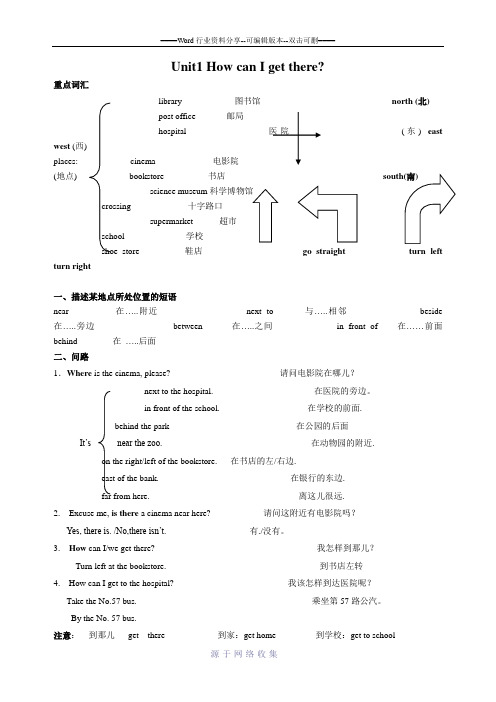
Unit1 How can I get there?重点词汇library 图书馆north (北)post office 邮局hospital 医院(东) east west (西)places: cinema 电影院(地点) bookstore 书店science museumcrossing 十字路口supermarket 超市school 学校shoe store 鞋店go straight turn left turn right一、描述某地点所处位置的短语near 在…..附近next to 与…..相邻beside 在…..旁边between 在…..之间in front of 在……前面behind 在…..后面二、问路1.Where is the cinema, please? 请问电影院在哪儿?next to the hospital. 在医院的旁边。
in front of the school. 在学校的前面.behind the park 在公园的后面It’s near the zoo. 在动物园的附近.on the right/left of the bookstore. 在书店的左/右边.east of the bank. 在银行的东边.far from here. 离这儿很远.2. Excuse me, is there a cinema near here? 请问这附近有电影院吗?Yes, there is. /No,there isn’t. 有./没有。
3. How can I/we get there? 我怎样到那儿?Turn left at the bookstore. 到书店左转4. How can I get to the hospital? 我该怎样到达医院呢?Take the No.57 bus. 乘坐第57路公汽。
By the No. 57 bus.注意:到那儿get there 到家:get home 到学校:get to school到某地get to Canada/Australia/Beijing/ Shanghai/Wuhan (城市)get to the hospital/zoo/bookstore (具体的建筑)二、指引路1. Go straight for 10 minutes. 直走10分钟2. Go straight to the cinema 直走到电影院3. Turn right/ left at the … 在… 地方向右/ 左转.4.Get on/off at the… 在什么地方上车/下车5.You can take the No.32 bus. 你可乘坐32路公交车去那儿.注意:You can go by the No.32 bus. 与上句意思一样,只是说法不同。
英语六年级上1~4单元复习资料
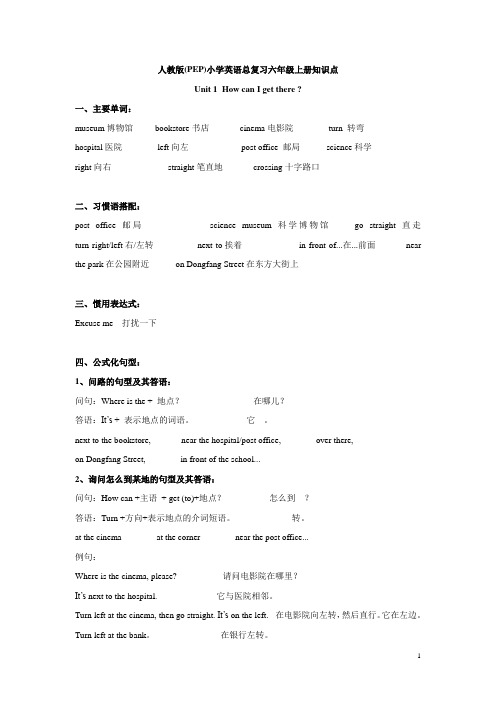
人教版(PEP)小学英语总复习六年级上册知识点Unit 1 How can I get there ?一、主要单词:museum博物馆bookstore书店cinema电影院turn 转弯hospital医院left向左post office 邮局science科学right向右straight笔直地crossing十字路口二、习惯语搭配:post office邮局science museum科学博物馆go straight直走turn right/left右/左转next to挨着in front of...在...前面near the park在公园附近on Dongfang Street在东方大街上三、惯用表达式:Excuse me 打扰一下四、公式化句型:1、问路的句型及其答语:问句:Where is the + 地点?···在哪儿?答语:It’s + 表示地点的词语。
它···。
next to the bookstore, near the hospital/post office, over there,on Dongfang Street, in front of the school...2、询问怎么到某地的句型及其答语:问句:How can +主语+ get (to)+地点?···怎么到···?答语:Turn +方向+表示地点的介词短语。
···转。
at the cinema at the corner near the post office...例句:Where is the cinema, please? 请问电影院在哪里?It’s next to the hospital. 它与医院相邻。
Turn left at the cinema, then go straight. It’s on the left. 在电影院向左转,然后直行。
人教版六年级上册英语各单元知识点汇总及提纲
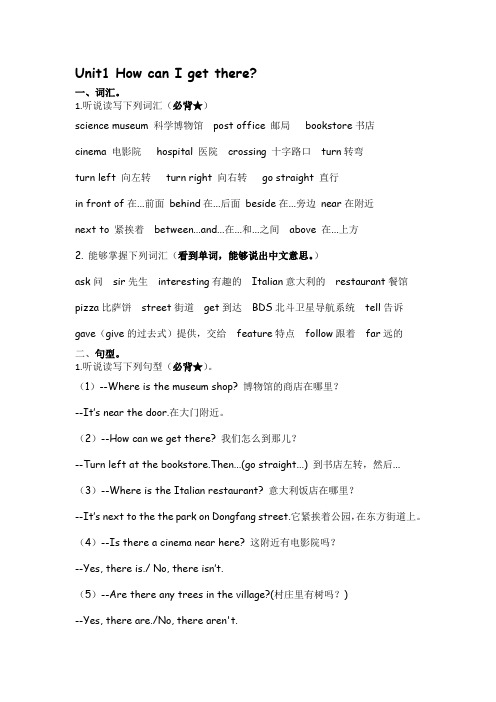
Unit1 How can I get there?一、词汇。
1.听说读写下列词汇(必背★)science museum 科学博物馆post office 邮局bookstore书店cinema 电影院hospital 医院crossing 十字路口turn转弯turn left 向左转turn right 向右转go straight 直行in front of在...前面behind在...后面beside在...旁边near在附近next to 紧挨着between...and...在...和...之间above 在...上方2.能够掌握下列词汇(看到单词,能够说出中文意思。
)ask问sir先生interesting有趣的Italian意大利的restaurant餐馆pizza比萨饼street街道get到达BDS北斗卫星导航系统tell告诉gave(give的过去式)提供,交给feature特点follow跟着far远的二、句型。
1.听说读写下列句型(必背★)。
(1)--Where is the museum shop? 博物馆的商店在哪里?--It’s near the door.在大门附近。
(2)--How can we get there? 我们怎么到那儿?--Turn left at the bookstore.Then...(go straight...) 到书店左转,然后... (3)--Where is the Italian restaurant? 意大利饭店在哪里?--It’s next to the the park on Dongfang street.它紧挨着公园,在东方街道上。
(4)--Is there a cinema near here? 这附近有电影院吗?--Yes, there is./ No, there isn’t.(5)--Are there any trees in the village?(村庄里有树吗?)--Yes, there are./No, there aren't.-Where is the hospital?-It’s in front of the cinema.-Where is the cinema?-It's in front of the hospital.2.听说认读下列句子(能够认读,理解中文意思)。
PEP小学英语六年级上册各单元知识点复习资料
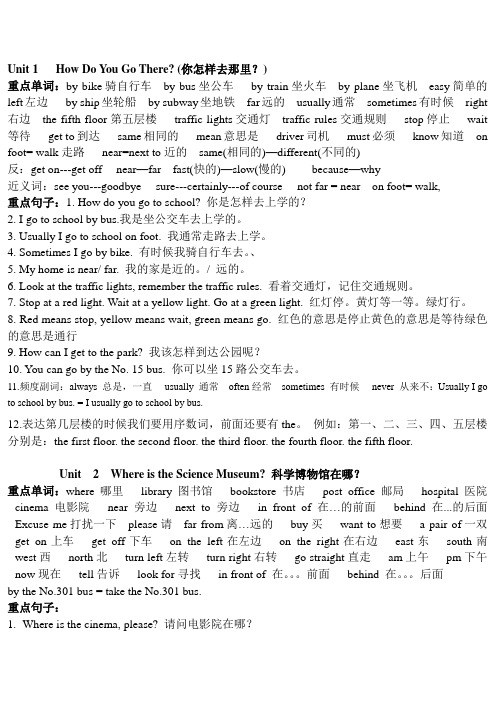
Unit 1 How Do Y ou Go There? (你怎样去那里?)重点单词:by bike骑自行车by bus坐公车by train坐火车by plane坐飞机easy简单的left左边by ship坐轮船by subway坐地铁far远的usually通常sometimes有时候right 右边the fifth floor第五层楼traffic lights交通灯traffic rules交通规则stop停止wait 等待get to到达same相同的mean意思是driver司机must必须know知道on foot= walk走路near=next to近的same(相同的)—different(不同的)反:get on---get off near—far fast(快的)—slow(慢的) because—why近义词:see you---goodbye sure---certainly---of course not far = near on foot= walk,重点句子:1. How do you go to school? 你是怎样去上学的?2. I go to school by bus.我是坐公交车去上学的。
3. Usually I go to school on foot. 我通常走路去上学。
4. Sometimes I go by bike. 有时候我骑自行车去。
、5. My home is near/ far. 我的家是近的。
/ 远的。
6. Look at the traffic lights, remember the traffic rules. 看着交通灯,记住交通规则。
7. Stop at a red light. Wait at a yellow light. Go at a green light. 红灯停。
黄灯等一等。
绿灯行。
8. Red means stop, yellow means wait, green means go. 红色的意思是停止黄色的意思是等待绿色的意思是通行9. How can I get to the park? 我该怎样到达公园呢?10. You can go by the No. 15 bus. 你可以坐15路公交车去。
新版PEP小学英语六年级上册1-6单元知识点总结(K12教育文档)
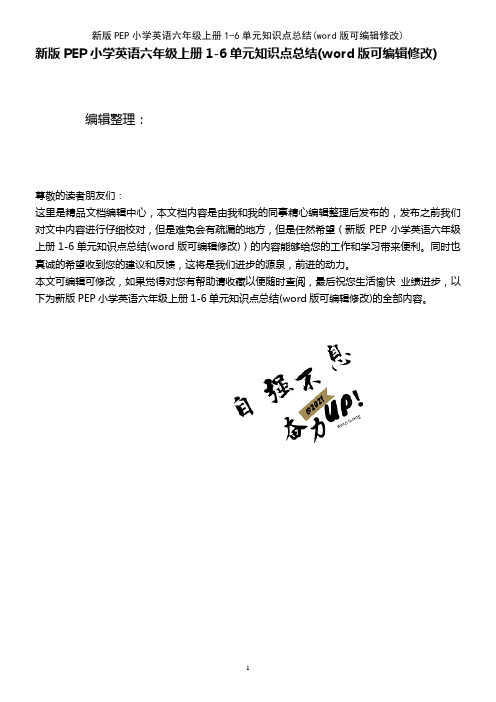
新版PEP小学英语六年级上册1-6单元知识点总结(word版可编辑修改) 编辑整理:尊敬的读者朋友们:这里是精品文档编辑中心,本文档内容是由我和我的同事精心编辑整理后发布的,发布之前我们对文中内容进行仔细校对,但是难免会有疏漏的地方,但是任然希望(新版PEP小学英语六年级上册1-6单元知识点总结(word版可编辑修改))的内容能够给您的工作和学习带来便利。
同时也真诚的希望收到您的建议和反馈,这将是我们进步的源泉,前进的动力。
本文可编辑可修改,如果觉得对您有帮助请收藏以便随时查阅,最后祝您生活愉快业绩进步,以下为新版PEP小学英语六年级上册1-6单元知识点总结(word版可编辑修改)的全部内容。
六年级PEP上册知识总结Unit1 How can I get there?library 图书馆north (北)post office 邮局hospital 医院turn left 左转 turn right 右转places: cinema 电影院(地点) bookstore 书店(东) east west (西)science muse科学博物馆pet hospital 宠物医院crossing 十字路口school 学校south(南) supermarket 超市shoe store 鞋店go straight 直行一、问路1.Where is the cinema, please? 请问电影院在哪儿?next to the hospital。
在医院的旁边。
in front of the school。
在学校的前面.behind the park 在公园的后面It’s near the zoo. 在动物园的附近.on the right/left of the bookstore. 在书店的左/右边。
east of the bank. 在银行的东边。
far from here. 离这儿很远.2. Excuse me, is there a cinema near here 请问这附近有电影院吗?Yes, there is. /No,there isn't. 有./没有。
六年级上册英语1-4单元必考知识点总结

Unit 3 What are you going to do?
一.词汇 'next week 下周
newsp叩er 报纸
this morning 今天上午
comic book漫画书
Time: (时间)
this afternoon 今天下午 this evening今天晚上
magazine 杂志 dictionary 字典
make kites (making kites )制作风筝 colLect stamps (collecting stamps)集邮
三单
Live (lives)居住,住 teach (teaches)教 go (goes)去 watch (watches)看 read (reads)读
其他show (展览)
(交通工具前加by,表示乘坐但步行要用on foot)
三会一
fifth第五 difference 不同 country 国家 right右边的 Australia澳大利亚 if如果
remember 记住 same相同的 mean意思是
side 边 however 但是 must必须
find找到 every每个所有的 drive驾驶
do (does) pen pal(笔友)
dear (亲爱的)
look(看上去)fun(快乐,乐趣)
with(同…)
三、重点句型:
1 .询问某人的爱好:
---------- What's your hobby?你的爱好是什么?
-----------1 Like collecting stamps.我喜欢集邮 2 .表示征求别人意见:
我坐飞机去。
■ ----------- How does your father go to work? ----------- He goes to work by subway.
(完整word版)PEP人教版六年级英语上册各单元复习要点
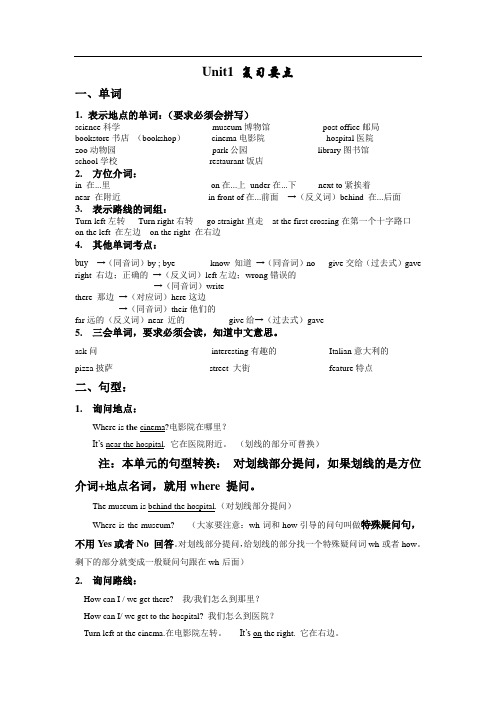
Unit1 复习要点一、单词1.表示地点的单词:(要求必须会拼写)science科学museum博物馆post office邮局bookstore书店(bookshop)cinema电影院hospital医院zoo动物园park公园library图书馆school学校restaurant饭店2.方位介词:in 在...里on在...上under在...下next to紧挨着near 在附近in front of在...前面→(反义词)behind 在...后面3.表示路线的词组:Turn left左转Turn right右转go straight直走at the first crossing在第一个十字路口on the left 在左边on the right 在右边4.其他单词考点:buy →(同音词)by ; bye know 知道→(同音词)no give交给(过去式)gave right 右边;正确的→(反义词)left左边;wrong错误的→(同音词)writethere 那边→(对应词)here这边→(同音词)their他们的far远的(反义词)near 近的give给→(过去式)gave5.三会单词,要求必须会读,知道中文意思。
ask问interesting有趣的Italian意大利的pizza披萨street 大街feature特点二、句型:1.询问地点:Where is the cinema?电影院在哪里?It’s near the hospital. 它在医院附近。
(划线的部分可替换)注:本单元的句型转换:对划线部分提问,如果划线的是方位介词+地点名词,就用where 提问。
The museum is behind the hospital.(对划线部分提问)Where is the museum? (大家要注意:wh-词和how引导的问句叫做特殊疑问句,不用Yes或者No 回答。
英语六年级上册U4-U6单元知识点总结

Unit 4 I have a pen pal 一、重点单词和短语pen pal笔友hobby爱好idea主意studies学习(第三人称单数)puzzle谜语hiking徒步旅行forest森林gift礼物sometimes有时angry 生气shout大喊bushy浓密的have to不得不get … from…从…得到…read books读书read stories读故事do kung fu练功夫play sports 进行体育运动play the pipa 弹琵琶climb mountains爬山listen to music听音乐sing English songs 唱英文歌fly kites放风筝on a farm在一个农场里write an e-mail to给…写邮件on the playground在运动场上live in住在二、按要求写单词have(第三人称单数)has do(单三形式)doesdo (否定形式)don’tdoes (否定形式)doesn’t like (单三形式)likeshe( 所有格形式) histalk(动词-ing形式) talking hobby(复数形式)hobbies story(复数形式)stories read(单三形式)reads live(单三形式)lives swim(动词-ing形式)swimmingdo(动词-ing形式) doing sing(动词-ing形式) singing go(动词-ing形式) goingteach(动词-ing形式) teachingalso(同义词)tooplay(动词-ing形式) playingstudent(复数)studentsdance(动词-ing形式)dancingwrite(动词-ing形式) writingpuzzle(复数)puzzleshike(动词-ing形式) hikinglearn(动词-ing形式)learningtrue(反义词)falsefriend(复数)friendscook(单三形式)cooksstudy(单三形式)studiesgo (单三形式)goesteach(单三形式)teachesdifferent(反义词)samemake(单三形式)makestalk (单三形式)talkslove (单三形式)lovessleep(单三形式)sleepslet(单三形式)letssing(单三形式)singsdance (单三形式)dancessang (原形)singwas(原形)is/amthrew(原形)throwlooked(原形)lookdid(原形)do/does三、重点句型分析1. 问:What are sb’s hobbies? 某人的爱好是什么?(询问某人的爱好)答:主语+like/likes +动词-ing形式(+其他)。
六年级上册一到六单元知识点英语教科版

六年级上册一到六单元知识点英语教科版1. 引言:1.1 概述:本篇长文旨在介绍六年级上册一到六单元的知识点,这些知识点是根据教科版英语教材编写的。
知识点包括单词学习、句型学习、语法要点等方面内容。
通过系统梳理和总结这些知识点,我们可以更好地理解和掌握六年级上册英语教材中的重要概念和技能。
1.2 文章结构:本篇文章按照单元顺序分为五个主要部分,分别是“第一单元知识点介绍”、“第二单元知识点总结”、“第三单元重点回顾”以及“第四至六单元知识系统梳理”。
每个部分都包含了该单元相关的具体内容,并提供了相应的学习方法和练习建议。
1.3 目的:通过撰写本篇长文,旨在帮助读者全面了解和掌握六年级上册一到六单元的英语知识点。
无论是进行复习巩固还是学习新知,读者都可以从文章中获得实用而有针对性的指导。
我们将从听说读写等多个方面展开讲解,旨在提高读者的综合语言能力和英语应用能力。
希望本篇长文对读者的英语学习有所助益,使他们能够更加自信地运用英语进行交流和表达。
2. 第一单元知识点介绍2.1 单词学习在第一单元中,学生将学习一些基础的英语单词。
这些单词包括日常生活中常见的名词、动词和形容词等。
通过学习这些单词,学生可以逐渐建立起自己的英语词汇库,并能够用这些单词来进行简单的交流。
2.2 句型学习除了学习单词外,第一单元还会介绍一些常用的句子结构。
这些句子结构包括基础的肯定句、否定句和疑问句等。
通过学习这些句子结构,学生可以掌握基本的语法规则,并能够正确运用它们来表达自己的意思。
2.3 语法要点在第一单元中,重点讲解了几个基础的语法要点。
其中包括:- 名词的复数形式:通过添加“s”或“es”来表示一个名词表示多个物品或人。
- 动词的时态:英语中动词有不同的时态,如现在时、过去时和将来时等。
学生需要了解这些时态并能够正确运用它们来描述事件发生的时间。
- 形容词的比较级和最高级:形容词可以用来描述事物的特征,而比较级和最高级则用于比较不同事物之间的特征。
2016—2017学年PEP人教版小学英语六年级上册1-6单元精品复习资料

六年级PEP上册知识总结转places:(地点) Unitl How can I get there? library 图书馆 ) post office 由E 局 hospital 医院 turn left 左转 turn right 右cinema 电影院 bookstore书店 science museums 学博物馆 crossing 十 字路口supermarket 超市 school 学校go straight 直行一、描述某地点所处位置的短语 near 在…..附近next to 与…..相令B beside 在…..旁边 in front of 在 ..... 前面 behind 在…..后面 between在…..之间二、问路1. Where is the cinema, please?next to the hospital. in front of the school. behind the parkIt ' s < near the zoo.far from here ・请问电影院在哪儿? 在医院的旁边。
在学校的前面. 在公园的后面 在动物园的附近・ 离这儿很远.2. Excuse me, is there a cinema near here Yes, there is. /No,there isrt ・ 请问这附近有电影院吗? 有・/没有。
3. How can I/we get there? Turn left at the bookstore. 我怎样到那儿? 到书店左转4. How can I get to the hospital? Take the No.57 bus. By the No. 57 bus.我该怎样到达医院呢? 乘坐第57路公汽。
注意:到那儿 到某地get thereget to Canada/Australia/Beijing/ Shanghai/Wuhan get to the hospital/zoo/bookstore、指引路1. You can take the No.32 bus ・ 你可乘坐312路公交车去那儿・ 注意:You can go by the No.32 bus.与上句意思一样,只是说法不同。
- 1、下载文档前请自行甄别文档内容的完整性,平台不提供额外的编辑、内容补充、找答案等附加服务。
- 2、"仅部分预览"的文档,不可在线预览部分如存在完整性等问题,可反馈申请退款(可完整预览的文档不适用该条件!)。
- 3、如文档侵犯您的权益,请联系客服反馈,我们会尽快为您处理(人工客服工作时间:9:00-18:30)。
Unit 4 the Mid-Autumn Festival is coming.
二.写出下列句子的汉语意思。
1.The Mid-Autumn Festival is coming. 中秋节就要来了
2.there be (is / are) 有,表存在
There are many mooncakes in the shopping centre. 购物中心有许多月饼
3.Let’s go and have a look. 咱们去看看吧。
4.A: Which type do you like? 你喜欢哪一种?
B: I like the ones with lotus seeds. 我喜欢有莲籽的月饼。
5.A: How much is a box of mooncakes? 一盒月饼多少钱?
B: It’s 50 yuan. 50元。
6.This mooncake tastes good. 这块月饼尝起来味道很好。
7.enjoy + 动词-ing
I enjoy eating mooncakes. 我喜欢吃月饼。
I enjoy looking at the moon. 我喜欢赏月。
8. I’d like a box of lotus seed mooncakes and a box of red bean mooncakes.
我想要一盒莲籽月饼和一盒红豆月饼。
Unit 5 It will be sunny and cool tomorrow.
二、写出下列句子的汉语意思。
描述未来的天气:
1. It will be + 形容词+时间,地点
It will be sunny and warm tomorrow. 明天天气明朗又温暖。
It will be clear in Shanghai. 上海天气将晴朗
1.there will be +名词+时间,地点
There will be a light snow next Monday. 下周一将有小雪There will be a strong wind in Xi’an. 西安将有大风。
2.It will +动词原形+时间地点
It will rain tomorrow in Changsha. 长沙明天将会下雨。
3.It’s time for the weather forecast. 到天气预报的时间了。
Unit 6 I will bring a big bottle of orange juice.
三.写出下列句子的汉语意思。
1.The weather is getting cool and nice. 天气变得凉爽又清晰。
2.We can have a picnic in the park. 我们可以在公园里野餐。
3.A: What are we going to bring for the picnic? 去野餐我们将要带什么?
B: I will bring a few bars of chocolate. 我将带几条巧克力。
4.A: When shall we meet? 我们什么时候见?
B: Let’s meet at the park at 9:00 a.m. 咱们早上九点在公园见吧。
5.I can’t wait for tomorrow to come. 我都等不及明天的到来了。
Unit 4-6 复习试题
一.单项选择。
( C )1. Let’s go and have a . A. see B. watch C. look
( B )2. I enjoy tea. A. drink B. drinking C. drinks
( C )3. ---- is a box of mooncake? ---- It’s 24 yuan.
A. How old
B. How many
C. How much
( A )4. ---- Which do you like ? ---- I like the ones with lotus seeds.
A. type
B. colour
C. shop
( B )5. This mooncake good. A. taste B. tastes C. tasted ( B )6. It will be and warm in Sanya. A. sun B. sunny C. the sun ( C )7. It’s time the weather forecast. A. to B. in C. for ( A )8. The wind in winter is so that just few students go to school.
A. strong
B. light
C. heavy
( A )9. will be a heavy rain tomorrow. A. There B. It C. This ( C )10. I bring some bars of chocolate. A. am B. don’t C. will ( C )11. Don’t for me. I will get there very late. A. look B. get C. wait ( B )12. The Mid-Autumn Festival is . A. comes B. coming C. come ( B )13. It will be clear Shanghai. A. on B. in C. out
( C )14. There will a light snow next Thursday. A. is B. are C. be ( B )15. I will bring three of apple juice here. A. bars B. bottles C. pieces 二.连词成句。
1. enjoy,at , moon, the, I , looking(.)
I enjoy looking at the moon.
2. be, will, strong, there, in, Xi’an, wind, a(.)
There will be a strong wind in Xi'an.
3. will, we, boxes, milk, five, bring, of(.)
We will bring five boxes of milk.
4.sunny, in, it, be, and, warm, Sanya, will
It will be sunny and warm in Sanya.
5. bottle, I, big, orange juice, will, a, bring, of(.)
I will bring a big bottle of orange juice.。
